
Picturing how advanced technologies are reshaping mobility Using augmented reality to explore how emerging technologies are ushering in the future of mobility
11 minute read
07 January 2019
 Craig Giffi United States
Craig Giffi United States Dan Littmann United States
Dan Littmann United States Kevin Westcott United States
Kevin Westcott United States Steve Schmith United States
Steve Schmith United States
When it comes to transportation and mobility, technological advances and shifting consumer expectations are paving the way for a future of mobility that could look very different from today.
Advancements in technology are affecting nearly every aspect of our lives. From health care to education to retail, technology is expanding choice, lowering cost, transforming customer experiences, upending business models, and changing how we engage with and value brands. And when it comes to transportation and mobility, advancements in powertrain and battery, safety, and connected and autonomous technologies—coupled with shifting consumer preferences—are paving the way for a future of mobility that will more than likely include shared fleets of autonomous vehicles and flying cars. Perhaps more than anything, these advanced technologies will profoundly alter the customer experience.
Learn more
Explore the Future of Mobility collection
Subscribe to receive related content from Deloitte Insights
This article is featured in Deloitte Review, issue 24
Download the issue
We believe that the journey to the future of mobility is already well underway. Examples abound of electrification, autonomous drive, smart and connected infrastructure, and disruptive business models. The emergence of 5G holds the promise of delivering fast, reliable, omnipresent connectivity. And innovations in other industries such as gaming are ushering in the possibilities of entirely new, immersive customer experiences delivered through augmented, virtual, and mixed reality.
To explore how advanced technologies already are and will continue to reshape the transportation ecosystem—and redefine and reshape people’s experiences as they move from one place to another—this article delivers a vision of the future enabled through augmented reality (AR). The trends that follow are ordered chronologically, beginning with how advanced technologies are today already changing how people buy cars. Each of the trends discussed is accompanied by an illustration that, when viewed through the Deloitte Digital DxR app, enables an AR experience that allows you to picture how advanced technologies will reshape mobility over the next 20 to 50 years.
Activate your augmented reality journey
Each of the illustrations accompanying the trends below is enabled with AR technology. Download and install the Deloitte Digital Reality DxR app from the Apple App Store or Google Play on your mobile device. To activate your AR-enabled journey, open the DxR app and place your device’s camera over an illustration.

Trend 1: Changing how people shop for cars
Shopping for a car isn’t something many consumers look forward to. It’s frustrating to invest time in researching vehicle and payment options only to find, upon arriving at a dealer’s lot, that the vehicle you want is not available and the payment options aren’t what you expected. And it’s even more frustrating when you compare the experience you enjoy with other brands to what happens on the showroom floor. Yet, according to Deloitte’s Global Automotive Consumer Study, consumers view the customer experience and their relationship with salespeople as integral to their final purchase decision.1 In fact, consumers around the world rank family, friends, and salespeople as the top sources for information when shopping for a vehicle.
So what do consumers dislike most about the process? Too much paperwork and an overall purchasing experience that just takes too much of their time. In addition, our research shows consumers are increasingly interested in buying a vehicle online without ever having to set foot inside of a dealership.
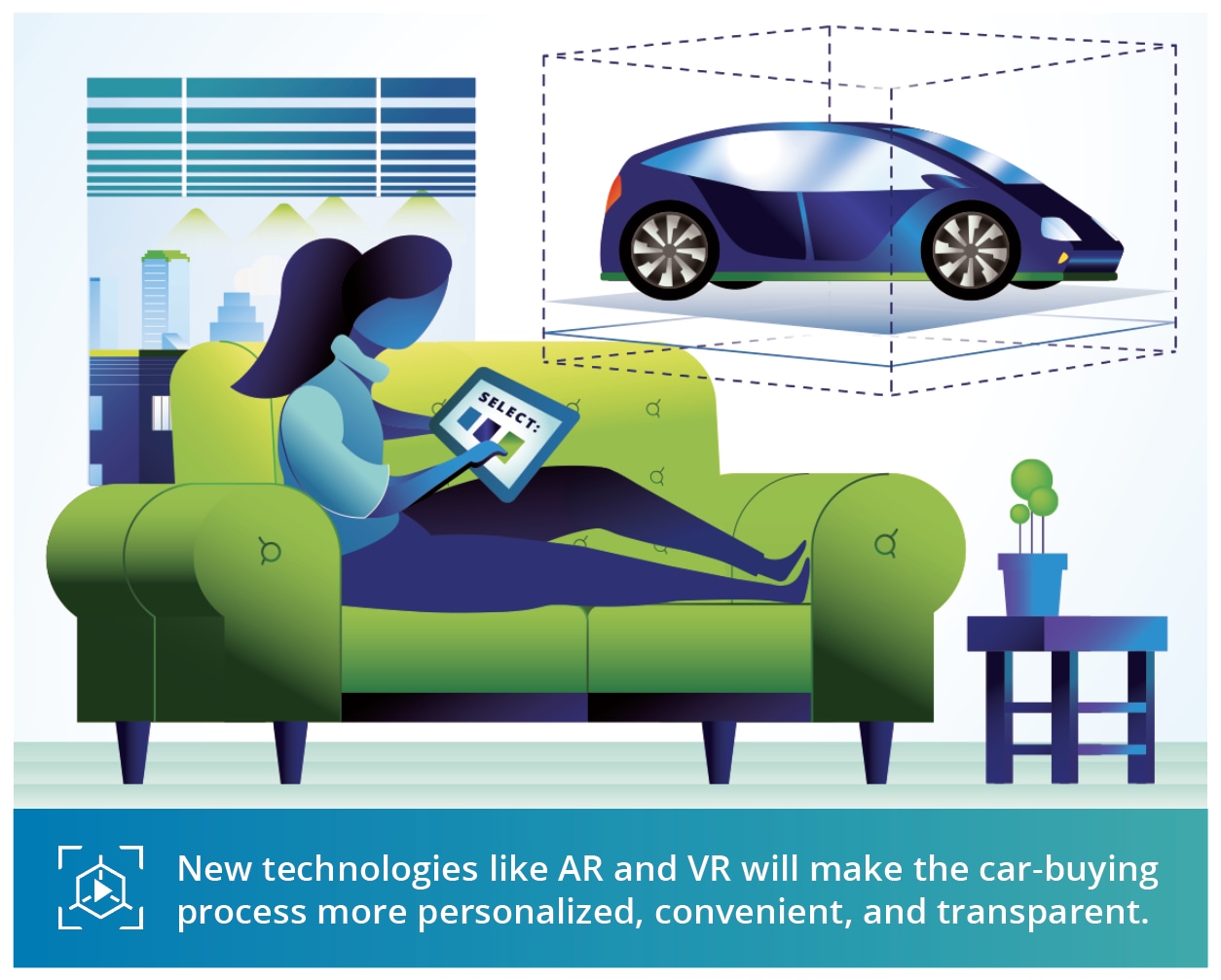
Advancements in VR technologies are poised to help both automakers and automotive dealers alleviate many of the pain points commonly associated with buying a vehicle. It also promises to create opportunities to engage consumers in entirely new ways while improving operations and the bottom line. Within the next three years, we anticipate significant growth in the use of VR technologies that allow consumers to compare models, build a vehicle and choose its features, “test drive” it, and then finance their purchase wherever and whenever they choose. That could include at shopping centers, airports, concerts, sporting events, and other attractions, as automakers and dealers create “pop-up” dealerships—VR-enabled kiosks that go where consumers are rather than requiring them to come to showrooms.
Creating a VR experience that sells cars requires mobile bandwidth intensity unmatched by today’s typical consumer applications such as streaming video. VR typically requires download speeds of at least 50 megabits per second, well beyond the capabilities of today’s wireless networks when they are operating at capacity. Hence, 5G will be an essential enabler of VR experiences due to its ability to support speeds 10 to 20 times greater than today’s LTE networks while allowing for location flexibility.
Moreover, 5G capabilities such as network slicing enable communications service providers to provide networks on an as-a-service basis and dynamically meet the demands of pop-up dealerships. Network slicing allows multiple logical networks with different performance characteristics to run on top a common physical network infrastructure. 5G with network slicing will ensure that network performance meets the bandwidth-intensive needs of a VR dealership experience.
Trend 2: Creating opportunities to engage consumers in transit
As autonomous vehicle technology matures and scales, opportunities will emerge for companies across a wide spectrum of industries to engage consumers while they are on the go but not focused on driving. Automotive original equipment manufacturers (OEMs) and suppliers, for example, can take the lead on designing and building vehicles whose interiors are modular, customizable, and embedded with screens, speakers, and other technologies that allow consumers to connect and interact with the world outside. Companies across the industry are already experimenting with innovations such as next-generation seating systems that are highly configurable; technologies that transform a vehicle’s windows into video monitors; and acoustic solutions that create individualized sound zones within a vehicle, allowing passengers to personalize their listening experience. As physiological barriers break down and people become more comfortable riding in autonomous vehicles, opportunities for never-before-imagined customization within the cockpit will emerge, allowing OEMs and other manufacturers to continue driving innovation—and imagination—about what the inside of a vehicle looks like.
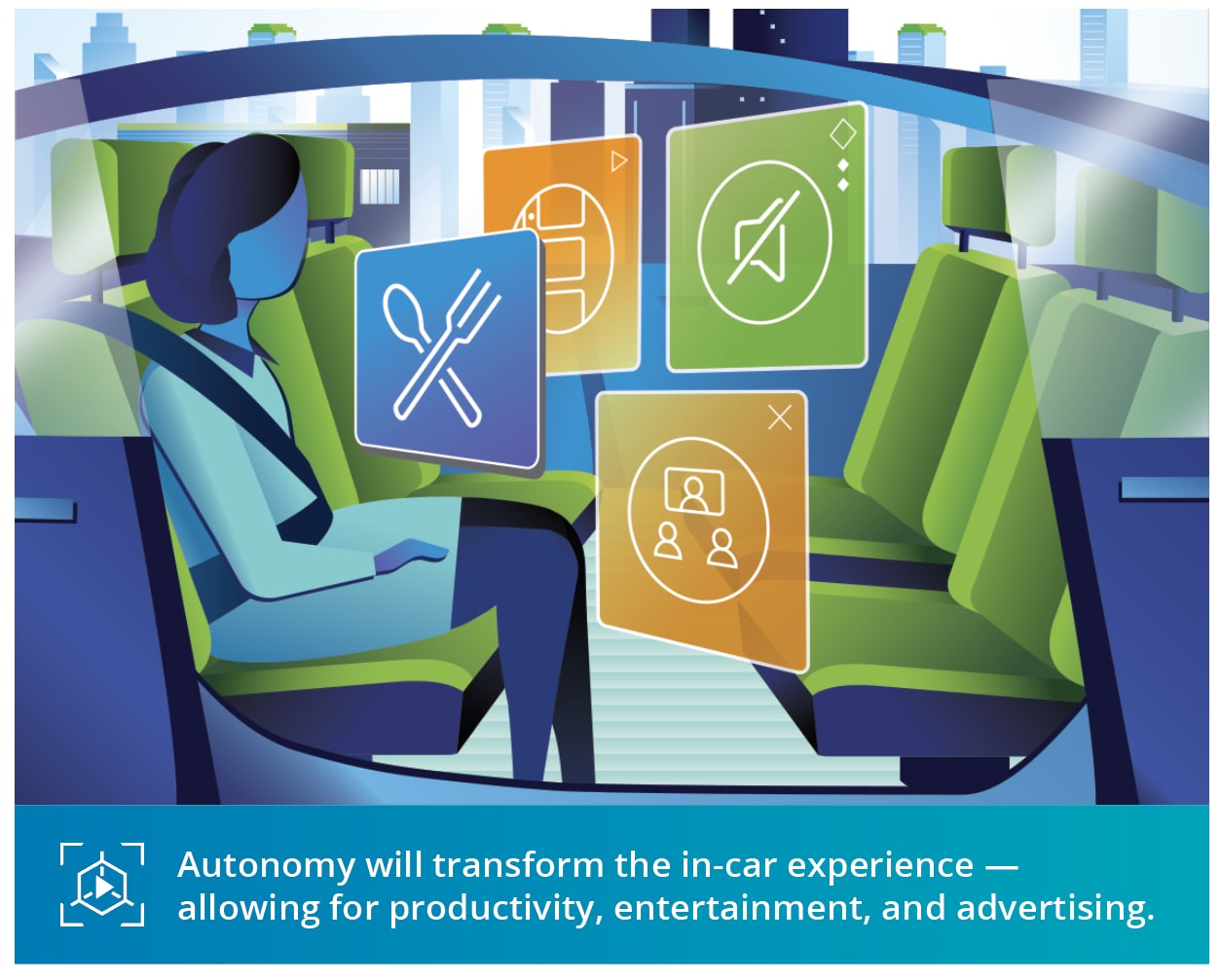
Today’s wireless networks will need to add massive capacity to accommodate these new in-vehicle experiences. The deployment of thousands of 5G small cells in densely populated urban and suburban areas will help accommodate the additional wireless traffic. However, alternative wireless technologies and unlicensed spectrum will also play an essential role. 5G enhances a device’s ability to switch seamlessly and efficiently across heterogeneous network technologies. Today, most video streaming occurs in the home, almost exclusively on unlicensed spectrum over WiFi. As more and more viewing shifts to people in transit, 5G’s heterogeneous network capability will help relieve the stress on licensed networks to intelligently find capacity via other networks with sufficient capacity to serve passengers’ information and entertainment needs.
Reliable connectivity will allow media and entertainment companies to discover new ways to connect with audiences within vehicles. New frontiers in retailing and advertising will emerge. We can even envision health care providers consulting with patients while they are in transit, using biometric sensors and cameras embedded throughout the vehicle.
But creating individualized experiences within the vehicle depends on more than connectivity and applications. Individual experiences are relatively simple to craft on smartphones, considering that most people own their own devices. However, cars are shared environments; shared not only with family members, but increasingly with strangers using rideshare applications. When a rider enters a vehicle, he or she will not want to deal with the time-consuming complexities of setting individual preferences. Instead, we envision a future where people’s preferences will be stored on the cloud and vehicles will automatically recognize individuals when they enter, adjusting music, video, news, advertising, and other customized preferences in real time. This capability requires advances in identity and device management that will accompany future connectivity offerings.
Trend 3: Enabling new pathways to value creation
Outside of the vehicle, autonomous and Internet of Things (IoT) technologies will usher in new opportunities to create and capture value. After passengers exit an autonomous and connected vehicle—regardless of whether it is personally owned or shared—the vehicle will still be able to interact with the connected world, completing tasks with little to no human interaction. For example, vehicles will be able to stop by highly automated warehouses or distribution centers to pick up groceries and other goods (conceivably loaded into the vehicle by autonomous forklifts or other automated material handling technology). Vehicles will be able to automatically schedule and go to service appointments for repair, maintenance, and, in the case of electrified vehicles, recharging. And they could become shared “for hire” vehicles, offering opportunities for people who personally own vehicles to earn money versus leaving the vehicle parked. These are only a few of the possibilities that could become reality at scale by 2040.
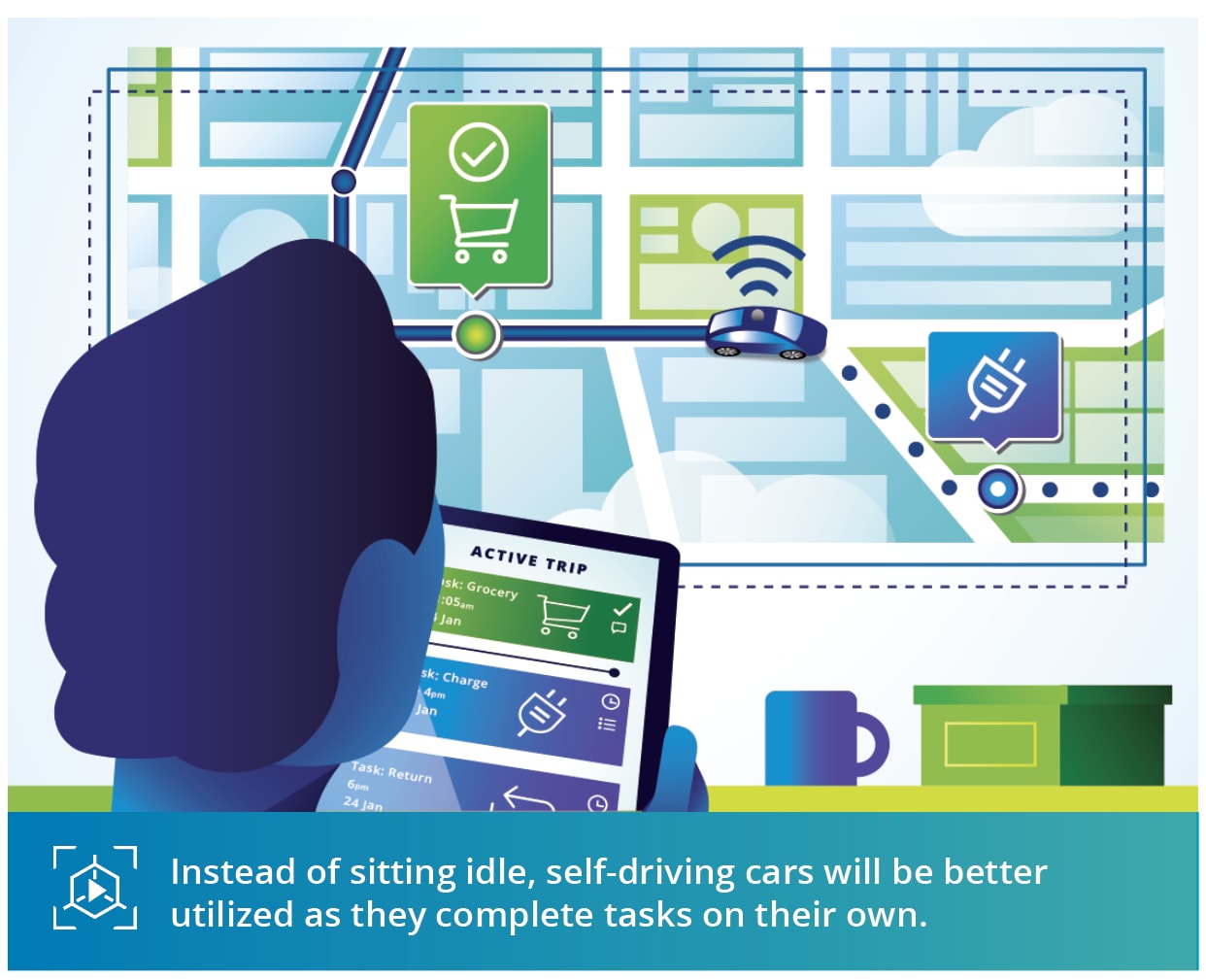
Onboard sensors, not mobile connectivity, power most autonomous vehicle capabilities and will continue to do so for the foreseeable future. However, 5G deployment will make connectivity an increasingly complementary part of the autonomous vehicle ecosystem. LTE has limits on the number of devices that can be provisioned on a mobile network. However, the massive device density 5G delivers allows for 1 million connections per square kilometer. The ability to recognize, connect, manage, and collect data from an almost unlimited number of devices on a single network allows for the machine-to-machine communications necessary for autonomous vehicles to interact in the ways described in the use cases above. This level of automation, where machines interact with one another and remove people from the equation, represents the next frontier of productivity gains for the economy across almost every industry sector.
And while autonomous vehicle operation may be self-contained,2 the vehicles could generate an increasing range of valuable data that would need to be offloaded. On average, an autonomous car in 2030 could be embedded with some 30 sensors (compared with about 17 sensors in 2015)3 generating hundreds of gigabytes of data every hour.4 These sensors would be unique to autonomous vehicles, helping them interpret their surroundings, smoothly navigate roads, and avoid obstacles and pedestrians. While not all of this data would be transmitted over cellular networks, some could be used to map the environment to feed machine learning/analytics to improve the autonomous vehicle’s operating system. The vehicle’s onboard software—including its operating system, voice assistance, and critical driving applications—could also consume vast quantities of data.5 Further, autonomous cars would depend on over-the-air updates for operating system software as well as high-definition 3D maps of their ever-changing surroundings to navigate to specific destinations with a higher degree of accuracy than what rideshare passengers experience today.
Trend 4: Transforming cities around the world
By mid-century, cities around the world will become massively connected ecosystems. Various elements of such “smart cities” will work in harmony to deliver a higher standard of living for residents by helping tackle issues such as congestion, pollution, public safety, and access to city services. These connected and smart urban ecosystems will be equipped with a wide variety of applications, each unique and with different purposes. As a result, citizens could see marked improvements in their standard of living, the environment, and the safety and security of, among other things, neighborhoods, workplaces, and airports.
Frictionless intermodal travel in a connected urban ecosystem will likely need to be built on a robust underlying infrastructure, both physical and digital. Traffic management systems, connected homes and devices, roadside sensors, roads and bridges, cybersecurity infrastructure, and a comprehensive telecommunications network seem necessary for this new mobility ecosystem to emerge. Connecting and conveying the status of critical components such as charging stations, traffic, dynamic pricing for infrastructure usage, and parking will also be crucial. And nearly all of the discrete opportunities discussed above depend upon the presence of ubiquitous, high-speed, reliable connectivity.
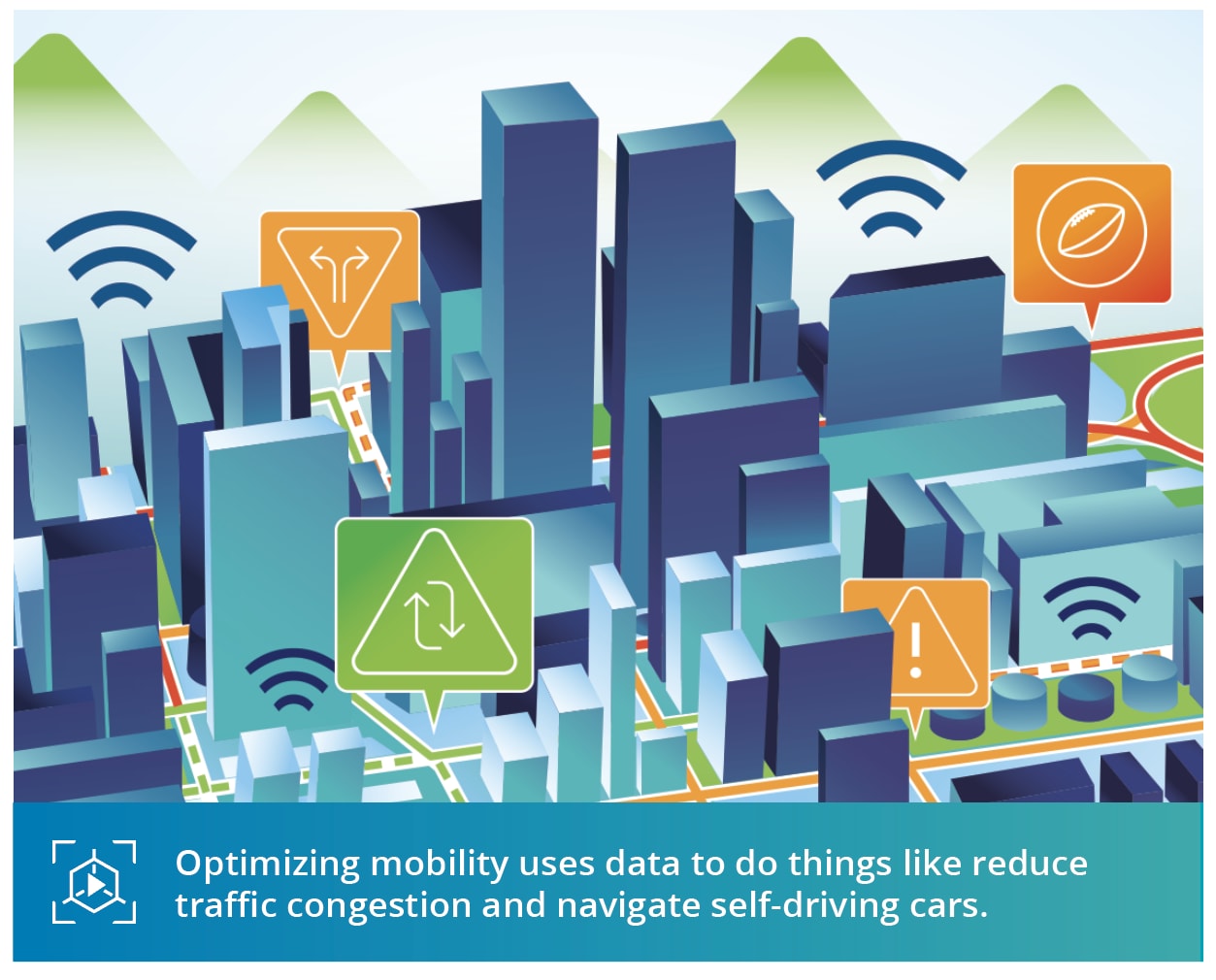
Urban planners and city transportation managers will also be able to capture huge amounts of data as people use cars, trains, and other mobility solutions. What it will take to secure these massive data networks from hackers and protect users’ privacy will expand exponentially. At the same time, the opportunities to analyze and visualize data for insights that improve decision-making related to transportation will grow significantly. For example, data related to traffic flows, vehicle locations, the movement of people, and crowd density can all be combined and harmonized so that city-wide, integrated transportation systems can be managed to meet system demands at any given time. Using this data, and with a highly networked and integrated transportation infrastructure, urban transportation managers will be able to adjust traffic-light timing to ease congestion, add or remove trains to match demand, reroute traffic patterns around large events, and clear transport lanes for first responders in the event of crisis.
Trend 5: Flying into a third dimension of travel
Between 2050 and 2080, we will likely see significant growth in a new dimension of mobility—up. The advanced technologies within and around vehicles discussed above will serve as the building blocks of a future where fleets of passenger drones and flying cars dot the skies.
Although those days are decades away, prototyping and testing of passenger drones and flying cars date back more than 30 years.6 Moreover, a number of manufacturers have announced plans to launch and/or deploy commercially viable unmanned aerial vehicles within the next three years. Some cities have announced the launch of flying-car programs by the end of the decade.
Still, we see a number of barriers that need to be addressed before flying cars will reach significant scale, from consumers’ psychology, safety, air traffic management, infrastructure, regulations, and the maturity of the technology itself. It may take decades to address these issues. Perfecting and proving these advanced vehicle technologies on the ground will also be a crucial stepping stone to consumer acceptance.
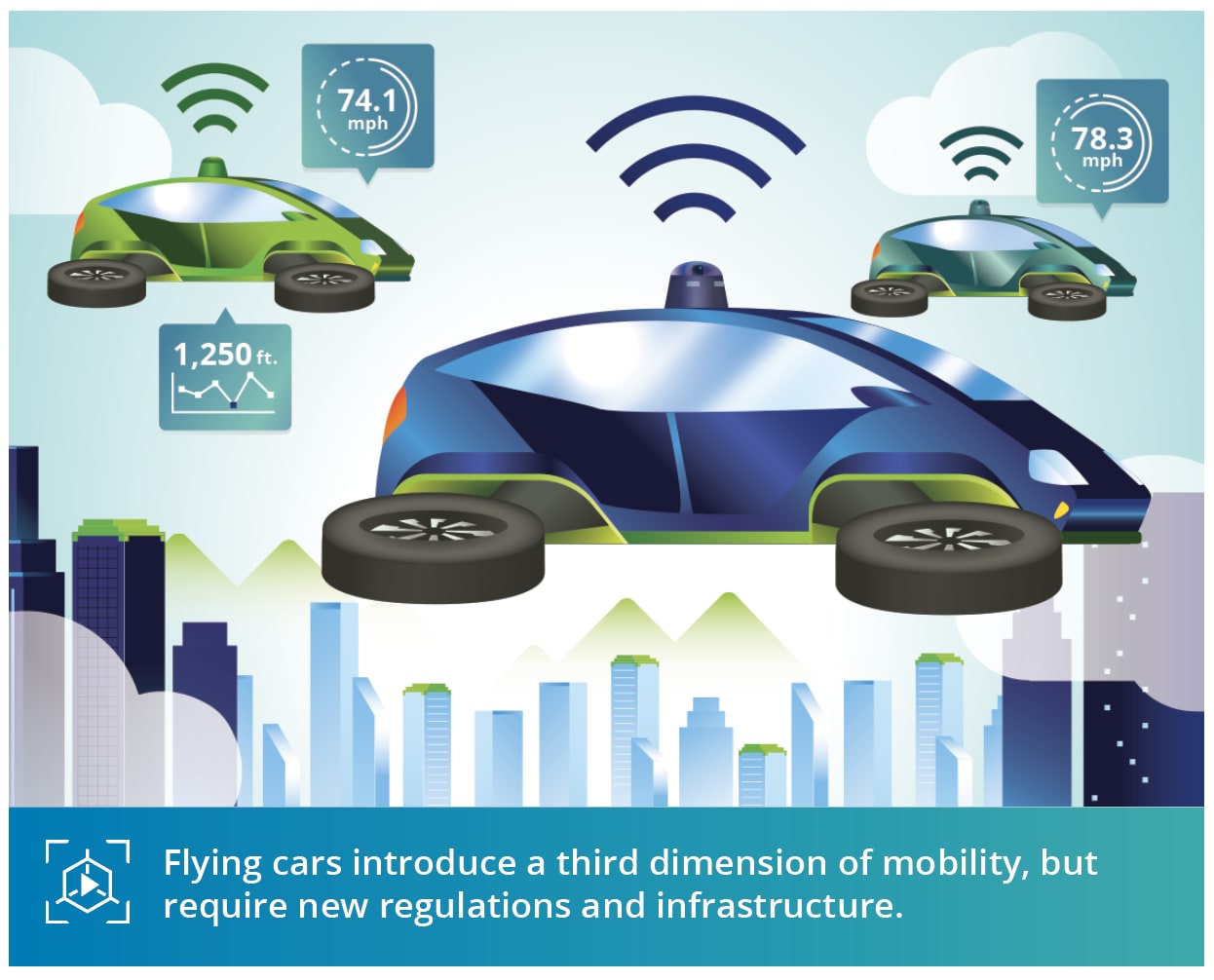
By the time hundreds of thousands of manned aerial drones take to the sky, communications requirements will stretch beyond today’s vision of 5G. However, some current features make it easier to imagine the technology required for it to become a reality. For example, 5G’s ultra-low latency theoretically allows for latencies of 1 millisecond (ms). While the difference between 100ms and 1ms isn’t apparent to the human eye, such speedy response times will be an imperative for safety and reliability in autonomous aerial scenarios. Furthermore, government oversight and regulation will become increasingly important, as will the need for greater computing power across the ecosystem.
Operating and maintaining fleets of flying drones will open new business opportunities and models. For example, ridesharing companies will be able to leverage their expertise in this new medium. Rental car companies will have opportunities around fleet management. Telecommunications and other technology companies will see opportunities to operate networks, as well as to work with retailers and media services to deliver next-generation customer experiences.
Toward a disruptive future of mobility—slowly but surely
The combination of these trends will usher in a new era of mobility and fundamentally change the movement of people and goods. Granted, the pace of this transformation is up for debate, and we will likely see multiple examples of these future scenarios in the market simultaneously.7 Unlike other rapid, exponential advancements in technology-driven innovation—such as the swift adoption of smartphones—we believe that advancements will be incremental, as will progress toward scale and mass adoption. Because the core of mobility centers around people and their safety, it may take decades to develop, test, perfect, and connect all the technologies and players. However, the potential for disruption and the emergence of opportunities is certain.
© 2021. See Terms of Use for more information.
Explore the Future of Mobility
-
Forces of change: The future of mobility Article7 years ago
-
The rise of mobility as a service Article8 years ago
-
How digital technologies can elevate car buying Article6 years ago
-
Toward a mobility operating system Article5 years ago
-
Securing the future of mobility Article8 years ago













